Hyundai Coupe 2006 Owner's Manual
Manufacturer: HYUNDAI, Model Year: 2006, Model line: Coupe, Model: Hyundai Coupe 2006Pages: 483, PDF Size: 12.73 MB
Page 291 of 483
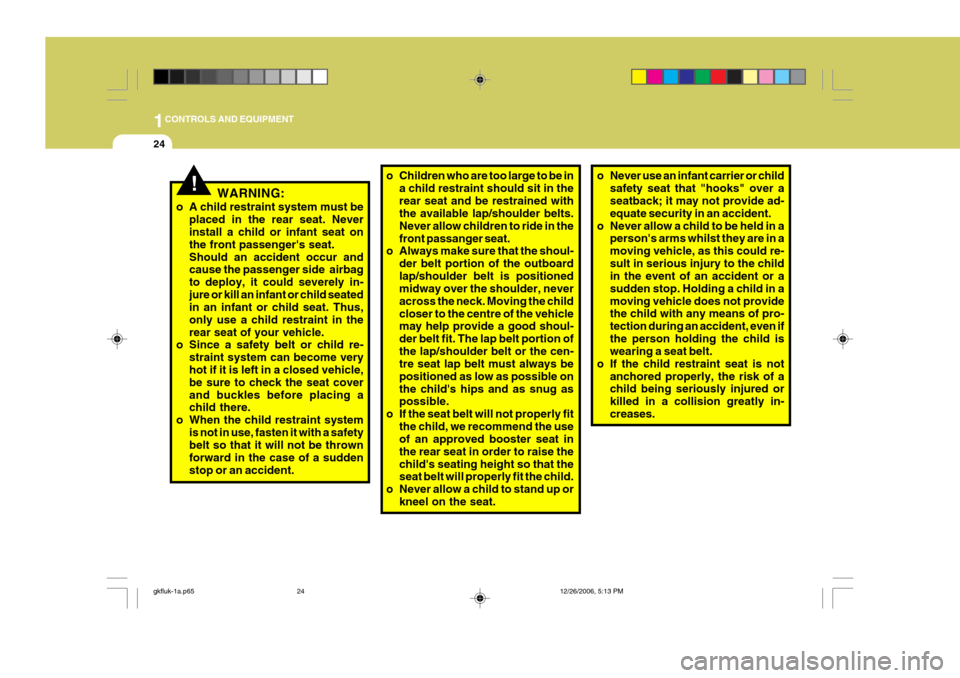
1CONTROLS AND EQUIPMENT
24
!WARNING:
o A child restraint system must be placed in the rear seat. Never install a child or infant seat on the front passenger's seat.Should an accident occur and cause the passenger side airbag to deploy, it could severely in-jure or kill an infant or child seated in an infant or child seat. Thus, only use a child restraint in therear seat of your vehicle.
o Since a safety belt or child re-
straint system can become very hot if it is left in a closed vehicle, be sure to check the seat coverand buckles before placing a child there.
o When the child restraint system is not in use, fasten it with a safetybelt so that it will not be thrown forward in the case of a suddenstop or an accident. o Never use an infant carrier or child
safety seat that "hooks" over a seatback; it may not provide ad- equate security in an accident.
o Never allow a child to be held in a person's arms whilst they are in amoving vehicle, as this could re-sult in serious injury to the child in the event of an accident or a sudden stop. Holding a child in amoving vehicle does not provide the child with any means of pro- tection during an accident, even ifthe person holding the child is wearing a seat belt.
o If the child restraint seat is not
anchored properly, the risk of achild being seriously injured or killed in a collision greatly in-creases.
o Children who are too large to be in
a child restraint should sit in therear seat and be restrained with the available lap/shoulder belts. Never allow children to ride in thefront passanger seat.
o Always make sure that the shoul-
der belt portion of the outboardlap/shoulder belt is positioned midway over the shoulder, never across the neck. Moving the childcloser to the centre of the vehicle may help provide a good shoul- der belt fit. The lap belt portion ofthe lap/shoulder belt or the cen- tre seat lap belt must always be positioned as low as possible onthe child's hips and as snug as possible.
o If the seat belt will not properly fit the child, we recommend the useof an approved booster seat in the rear seat in order to raise thechild's seating height so that the seat belt will properly fit the child.
o Never allow a child to stand up or kneel on the seat.
gkfluk-1a.p65 12/26/2006, 5:13 PM
24
Page 292 of 483
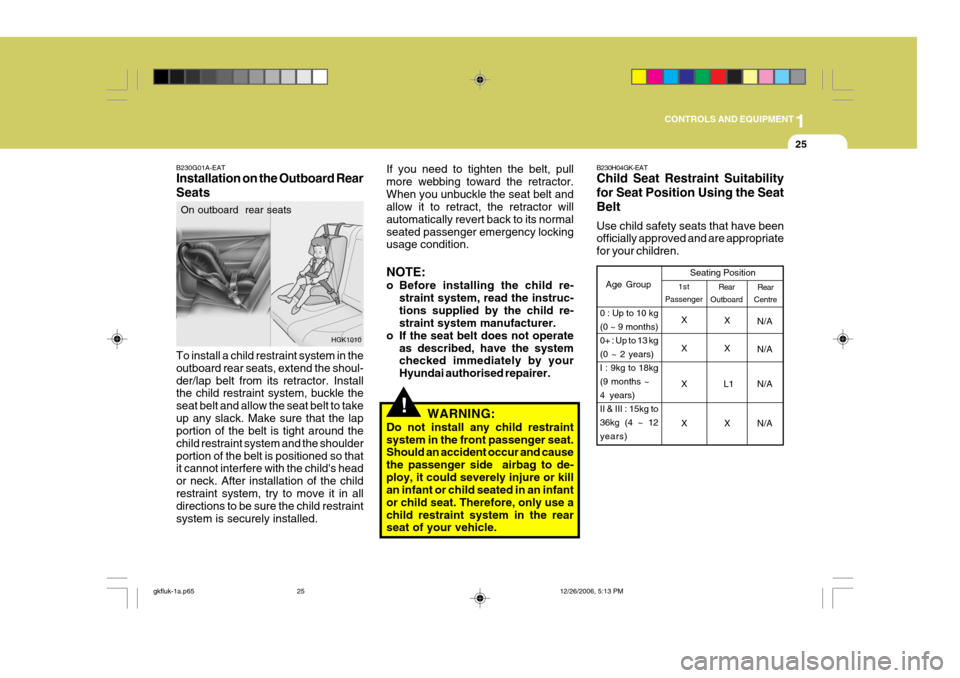
1
CONTROLS AND EQUIPMENT
25
!
If you need to tighten the belt, pull more webbing toward the retractor.When you unbuckle the seat belt and allow it to retract, the retractor will automatically revert back to its normalseated passenger emergency locking usage condition. NOTE:
o Before installing the child re-
straint system, read the instruc- tions supplied by the child re- straint system manufacturer.
o If the seat belt does not operate
as described, have the systemchecked immediately by your Hyundai authorised repairer.
WARNING:
Do not install any child restraintsystem in the front passenger seat. Should an accident occur and cause the passenger side airbag to de-ploy, it could severely injure or kill an infant or child seated in an infant or child seat. Therefore, only use achild restraint system in the rear seat of your vehicle.B230G01A-EAT Installation on the Outboard Rear Seats To install a child restraint system in the outboard rear seats, extend the shoul-der/lap belt from its retractor. Install the child restraint system, buckle the seat belt and allow the seat belt to takeup any slack. Make sure that the lap portion of the belt is tight around the child restraint system and the shoulderportion of the belt is positioned so that it cannot interfere with the child's head or neck. After installation of the childrestraint system, try to move it in all directions to be sure the child restraint system is securely installed. On outboard rear seats
HGK1010 B230H04GK-EAT Child Seat Restraint Suitability for Seat Position Using the SeatBelt Use child safety seats that have been officially approved and are appropriate for your children.
Rear
Centre
Age Group Seating Position
X
N/A
XX N/A
X L1 N/A
X X N/A Rear
Outboard
1st
Passenger
0 : Up to 10 kg (0 ~ 9 months)0+ : Up to 13 kg(0 ~ 2 years)I : 9kg to 18kg(9 months ~4 years)II & III : 15kg to36kg (4 ~ 12years) X
gkfluk-1a.p65
12/26/2006, 5:13 PM
25
Page 293 of 483
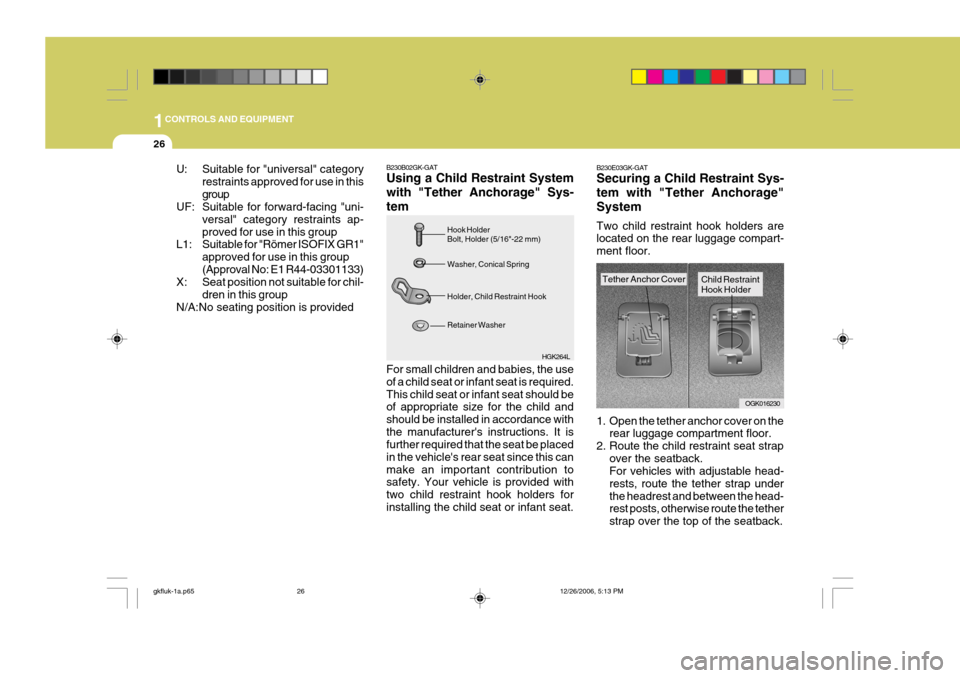
1CONTROLS AND EQUIPMENT
26
B230E03GK-GAT Securing a Child Restraint Sys- tem with "Tether Anchorage"System Two child restraint hook holders are located on the rear luggage compart- ment floor.
OGK016230
Tether Anchor Cover
Child Restraint Hook Holder
1. Open the tether anchor cover on the
rear luggage compartment floor.
2. Route the child restraint seat strap over the seatback. For vehicles with adjustable head- rests, route the tether strap underthe headrest and between the head- rest posts, otherwise route the tether strap over the top of the seatback.
B230B02GK-GAT Using a Child Restraint System with "Tether Anchorage" Sys-tem For small children and babies, the use of a child seat or infant seat is required.This child seat or infant seat should be of appropriate size for the child and should be installed in accordance withthe manufacturer's instructions. It is further required that the seat be placed in the vehicle's rear seat since this canmake an important contribution to safety. Your vehicle is provided with two child restraint hook holders forinstalling the child seat or infant seat. HGK264L
Hook Holder Bolt, Holder (5/16"-22 mm) Washer, Conical Spring Holder, Child Restraint Hook Retainer Washer
U: Suitable for "universal" category
restraints approved for use in this group
UF: Suitable for forward-facing "uni-
versal" category restraints ap-proved for use in this group
L1: Suitable for "Römer ISOFIX GR1"
approved for use in this group(Approval No: E1 R44-03301133)
X: Seat position not suitable for chil-
dren in this group
N/A:No seating position is provided
gkfluk-1a.p65 12/26/2006, 5:13 PM
26
Page 294 of 483
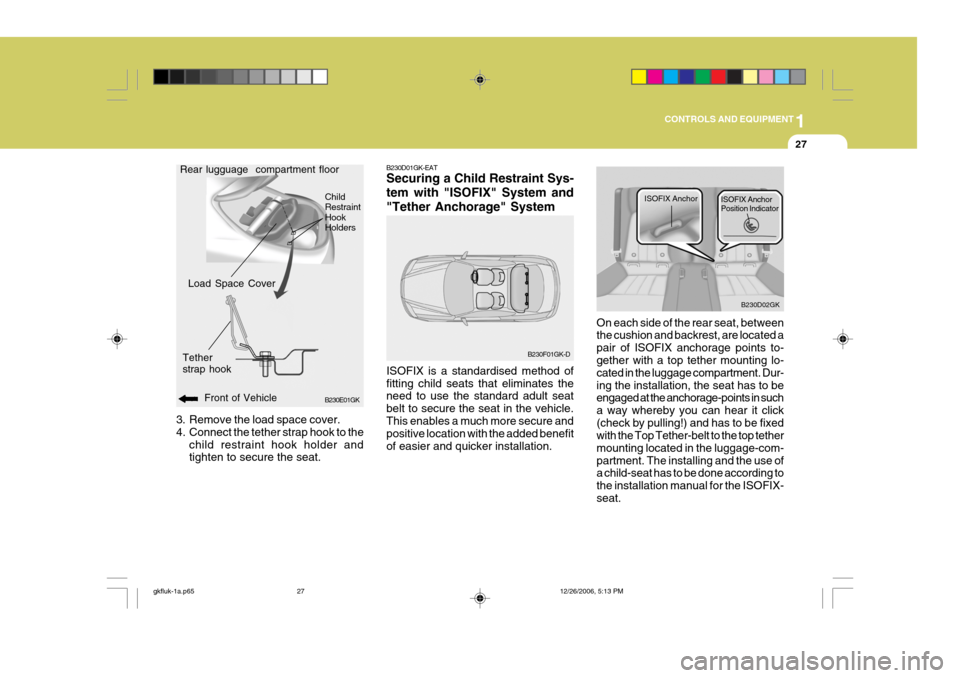
1
CONTROLS AND EQUIPMENT
27
B230D02GK
ISOFIX Anchor
ISOFIX Anchor Position Indicator
3. Remove the load space cover.
4. Connect the tether strap hook to the
child restraint hook holder and tighten to secure the seat. B230D01GK-EAT Securing a Child Restraint Sys- tem with "ISOFIX" System and"Tether Anchorage" System ISOFIX is a standardised method of fitting child seats that eliminates the need to use the standard adult seat belt to secure the seat in the vehicle.This enables a much more secure and positive location with the added benefit of easier and quicker installation.
B230E01GK
Front of Vehicle
Load Space Cover
Tether strap hook
Rear lugguage compartment floor
B230F01GK-D
Child RestraintHookHoldersOn each side of the rear seat, between the cushion and backrest, are located a pair of ISOFIX anchorage points to- gether with a top tether mounting lo- cated in the luggage compartment. Dur-ing the installation, the seat has to be engaged at the anchorage-points in such a way whereby you can hear it click(check by pulling!) and has to be fixed with the Top Tether-belt to the top tether mounting located in the luggage-com-partment. The installing and the use of a child-seat has to be done according to the installation manual for the ISOFIX-seat.
gkfluk-1a.p65 12/26/2006, 5:13 PM
27
Page 295 of 483
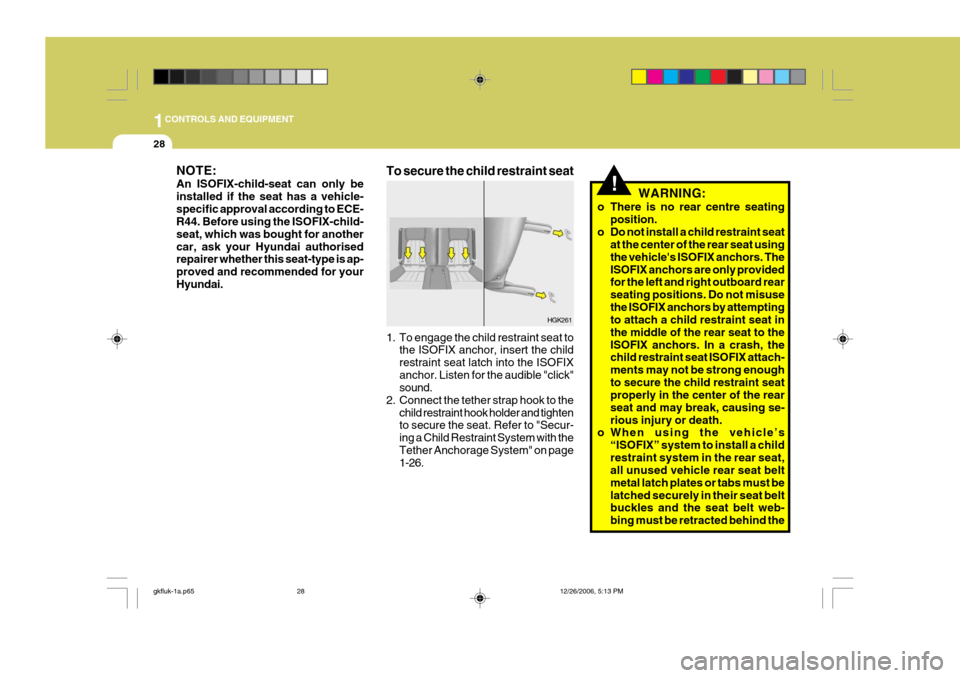
1CONTROLS AND EQUIPMENT
28
!WARNING:
o There is no rear centre seating position.
o Do not install a child restraint seat at the center of the rear seat using the vehicle's ISOFIX anchors. TheISOFIX anchors are only provided for the left and right outboard rear seating positions. Do not misusethe ISOFIX anchors by attempting to attach a child restraint seat in the middle of the rear seat to theISOFIX anchors. In a crash, the child restraint seat ISOFIX attach- ments may not be strong enoughto secure the child restraint seat properly in the center of the rear seat and may break, causing se-rious injury or death.
o When using the vehicle’s
“ISOFIX” system to install a childrestraint system in the rear seat, all unused vehicle rear seat belt metal latch plates or tabs must belatched securely in their seat belt buckles and the seat belt web- bing must be retracted behind the
NOTE: An ISOFIX-child-seat can only be installed if the seat has a vehicle-specific approval according to ECE- R44. Before using the ISOFIX-child- seat, which was bought for anothercar, ask your Hyundai authorised repairer whether this seat-type is ap- proved and recommended for yourHyundai. To secure the child restraint seat
1. To engage the child restraint seat to
the ISOFIX anchor, insert the child restraint seat latch into the ISOFIXanchor. Listen for the audible "click" sound.
2. Connect the tether strap hook to the child restraint hook holder and tightento secure the seat. Refer to "Secur- ing a Child Restraint System with theTether Anchorage System" on page 1-26. HGK261
gkfluk-1a.p65
12/26/2006, 5:13 PM
28
Page 296 of 483
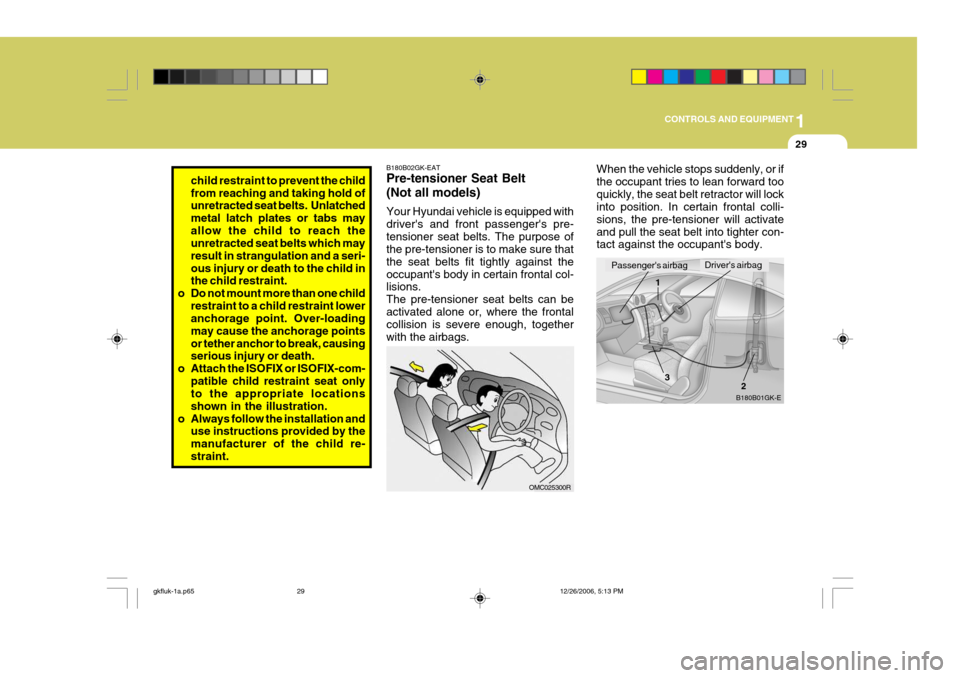
1
CONTROLS AND EQUIPMENT
29
B180B02GK-EAT Pre-tensioner Seat Belt (Not all models) Your Hyundai vehicle is equipped with driver's and front passenger's pre-tensioner seat belts. The purpose of the pre-tensioner is to make sure that the seat belts fit tightly against theoccupant's body in certain frontal col- lisions. The pre-tensioner seat belts can beactivated alone or, where the frontal collision is severe enough, together with the airbags. When the vehicle stops suddenly, or ifthe occupant tries to lean forward tooquickly, the seat belt retractor will lock into position. In certain frontal colli- sions, the pre-tensioner will activateand pull the seat belt into tighter con- tact against the occupant's body.
OMC025300R B180B01GK-E
Driver's airbag
1
2
3
Passenger's airbag
child restraint to
prevent the child
from reaching and taking hold of
unretracted seat belts. Unlatched metal latch plates or tabs mayallow the child to reach the unretracted seat belts which may result in strangulation and a seri-ous injury or death to the child in the child restraint.
o Do not mount more than one child restraint to a child restraint loweranchorage point. Over-loading may cause the anchorage pointsor tether anchor to break, causing serious injury or death.
o Attach the ISOFIX or ISOFIX-com- patible child restraint seat onlyto the appropriate locations shown in the illustration.
o Always follow the installation and use instructions provided by themanufacturer of the child re-straint.
gkfluk-1a.p65 12/26/2006, 5:13 PM
29
Page 297 of 483
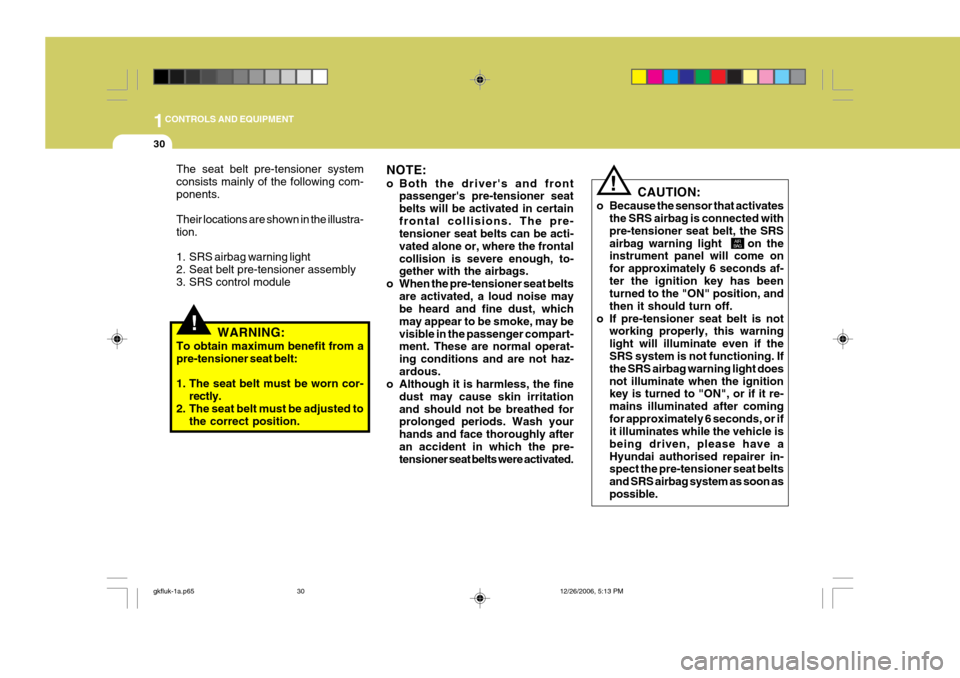
1CONTROLS AND EQUIPMENT
30
!
!
NOTE:
o Both the driver's and front
passenger's pre-tensioner seat belts will be activated in certainfrontal collisions. The pre- tensioner seat belts can be acti- vated alone or, where the frontalcollision is severe enough, to- gether with the airbags.
o When the pre-tensioner seat belts are activated, a loud noise maybe heard and fine dust, which may appear to be smoke, may bevisible in the passenger compart- ment. These are normal operat- ing conditions and are not haz-ardous.
o Although it is harmless, the fine
dust may cause skin irritationand should not be breathed for prolonged periods. Wash your hands and face thoroughly afteran accident in which the pre- tensioner seat belts were activated. CAUTION:
o Because the sensor that activates the SRS airbag is connected with pre-tensioner seat belt, the SRSairbag warning light on the instrument panel will come on for approximately 6 seconds af-ter the ignition key has been turned to the "ON" position, and then it should turn off.
o If pre-tensioner seat belt is not working properly, this warninglight will illuminate even if the SRS system is not functioning. If the SRS airbag warning light doesnot illuminate when the ignition key is turned to "ON", or if it re- mains illuminated after comingfor approximately 6 seconds, or if it illuminates while the vehicle is being driven, please have aHyundai authorised repairer in- spect the pre-tensioner seat belts and SRS airbag system as soon aspossible.
AIR
BAG
The seat belt pre-tensioner system consists mainly of the following com-ponents. Their locations are shown in the illustra- tion.
1. SRS airbag warning light
2. Seat belt pre-tensioner assembly
3. SRS control module
WARNING:
To obtain maximum benefit from a pre-tensioner seat belt:
1. The seat belt must be worn cor- rectly.
2. The seat belt must be adjusted to
the correct position.
gkfluk-1a.p65 12/26/2006, 5:13 PM
30
Page 298 of 483
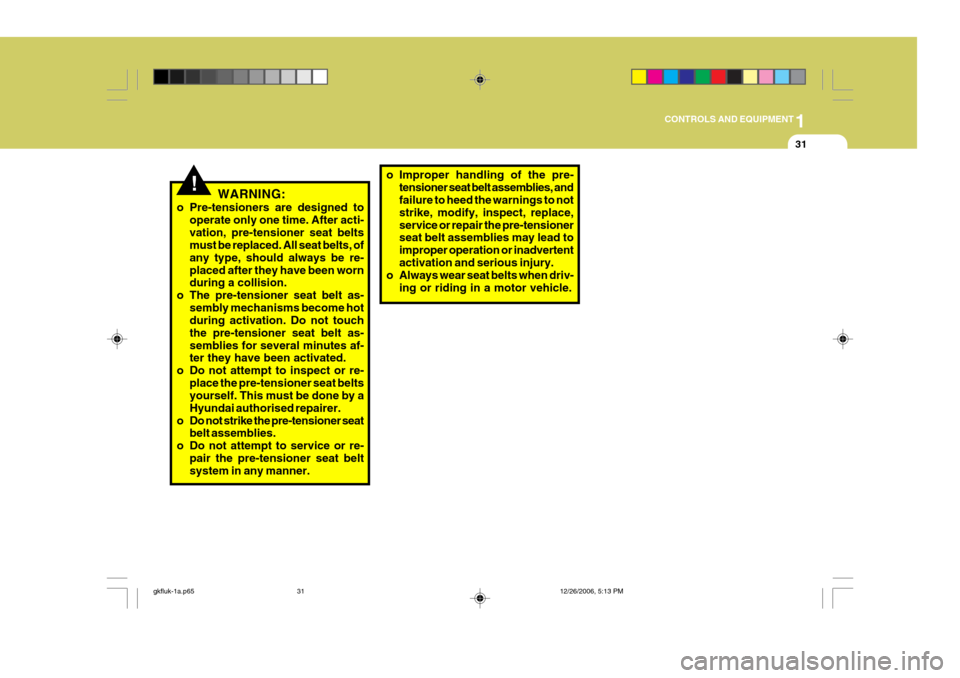
1
CONTROLS AND EQUIPMENT
31
o Improper handling of the pre-
tensioner seat belt assemblies, and failure to heed the warnings to not strike, modify, inspect, replace,service or repair the pre-tensioner seat belt assemblies may lead to improper operation or inadvertentactivation and serious injury.
o Always wear seat belts when driv-
ing or riding in a motor vehicle.
!WARNING:
o Pre-tensioners are designed to operate only one time. After acti- vation, pre-tensioner seat belts must be replaced. All seat belts, of any type, should always be re-placed after they have been worn during a collision.
o The pre-tensioner seat belt as- sembly mechanisms become hotduring activation. Do not touch the pre-tensioner seat belt as-semblies for several minutes af- ter they have been activated.
o Do not attempt to inspect or re- place the pre-tensioner seat beltsyourself. This must be done by a Hyundai authorised repairer.
o Do not strike the pre-tensioner seat belt assemblies.
o Do not attempt to service or re- pair the pre-tensioner seat belt system in any manner.
gkfluk-1a.p65 12/26/2006, 5:13 PM
31
Page 299 of 483
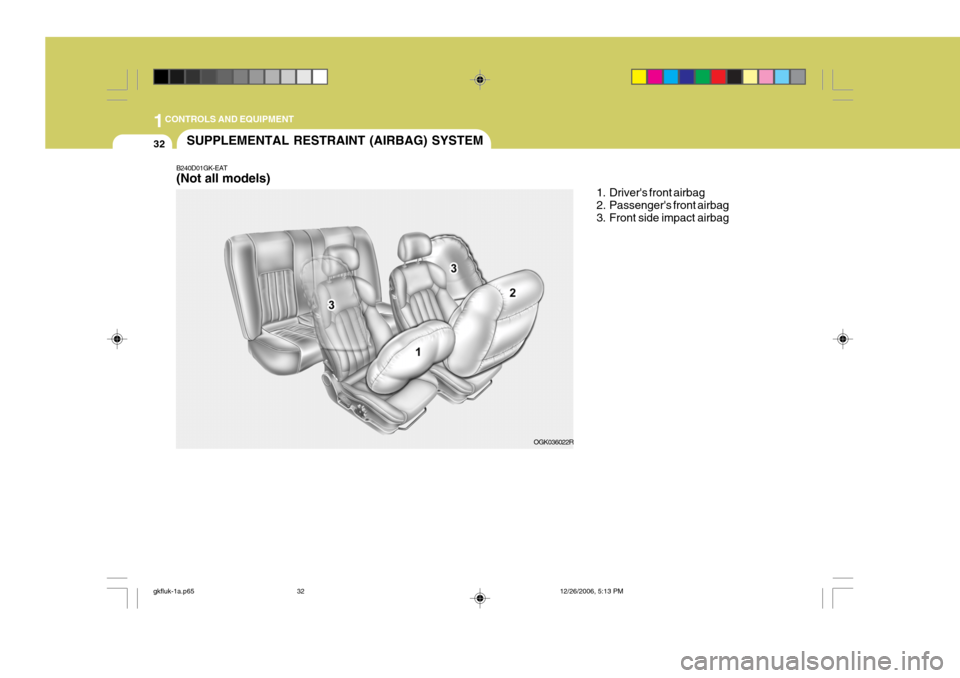
1CONTROLS AND EQUIPMENT
32
B240D01GK-EAT (Not all models)
SUPPLEMENTAL RESTRAINT (AIRBAG) SYSTEM
1. Driver's front airbag
2. Passenger's front airbag
3. Front side impact airbag
OGK036022R
gkfluk-1a.p65 12/26/2006, 5:13 PM
32
Page 300 of 483
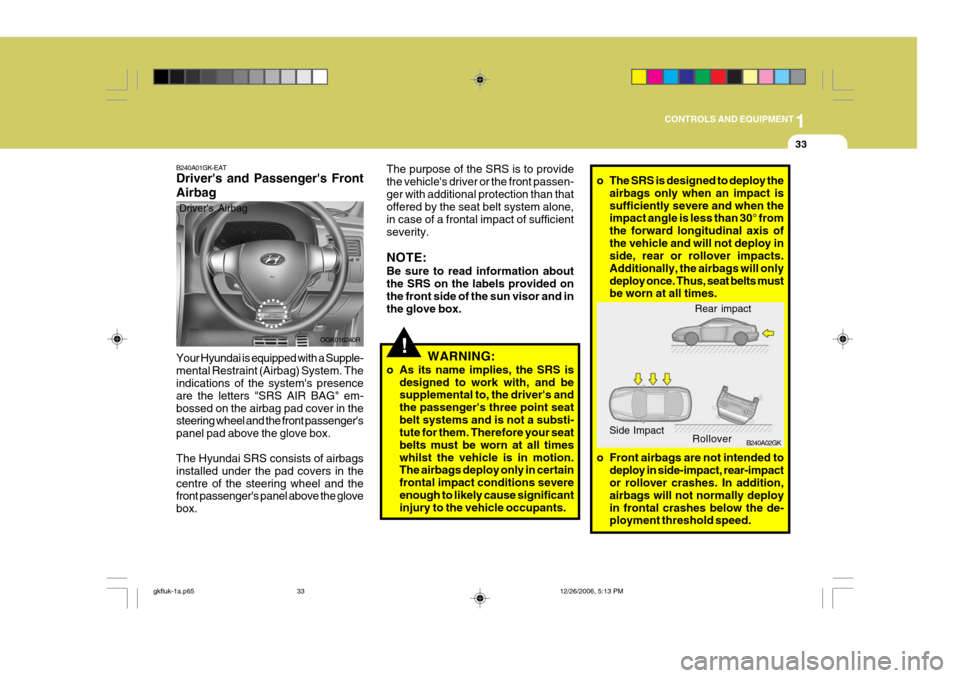
1
CONTROLS AND EQUIPMENT
33
!
The purpose of the SRS is to provide the vehicle's driver or the front passen-ger with additional protection than that offered by the seat belt system alone, in case of a frontal impact of sufficientseverity. NOTE: Be sure to read information about the SRS on the labels provided onthe front side of the sun visor and in the glove box.
WARNING:
o As its name implies, the SRS is designed to work with, and besupplemental to, the driver's and the passenger's three point seatbelt systems and is not a substi- tute for them. Therefore your seat belts must be worn at all timeswhilst the vehicle is in motion. The airbags deploy only in certain frontal impact conditions severeenough to likely cause significant injury to the vehicle occupants.o The SRS is designed to deploy theairbags only when an impact is sufficiently severe and when the impact angle is less than 30° from the forward longitudinal axis ofthe vehicle and will not deploy in side, rear or rollover impacts. Additionally, the airbags will onlydeploy once. Thus, seat belts must be worn at all times.
o Front airbags are not intended to deploy in side-impact, rear-impactor rollover crashes. In addition, airbags will not normally deployin frontal crashes below the de- ployment threshold speed. Rear impact
B240A02GK
Side Impact
Rollover
B240A01GK-EAT Driver's and Passenger's Front Airbag Your Hyundai is equipped with a Supple- mental Restraint (Airbag) System. The indications of the system's presence are the letters "SRS AIR BAG" em-bossed on the airbag pad cover in the steering wheel and the front passenger's panel pad above the glove box. The Hyundai SRS consists of airbags installed under the pad covers in thecentre of the steering wheel and the front passenger's panel above the glove box.Driver's Airbag
OGK016240R
gkfluk-1a.p65 12/26/2006, 5:13 PM
33